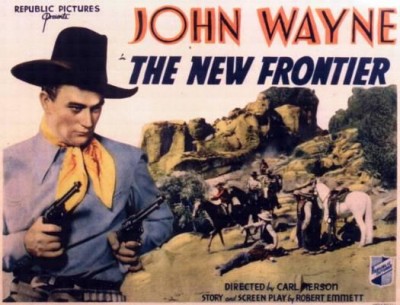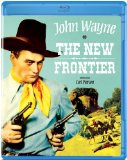| Reviews & Columns |
|
Reviews DVD TV on DVD Blu-ray 4K UHD International DVDs In Theaters Reviews by Studio Video Games Features Collector Series DVDs Easter Egg Database Interviews DVD Talk Radio Feature Articles Columns Anime Talk DVD Savant Horror DVDs The M.O.D. Squad Art House HD Talk Silent DVD
|
DVD Talk Forum |
|
|
| Resources |
|
DVD Price Search Customer Service #'s RCE Info Links |
|
Columns
|
|
|
New Frontier, The
(The New Frontier is not to be confused with another John Wayne-Republic Pictures movie, New Frontier (1939), which was a Three Mesquiteers entry co-starring Ray Corrigan and Raymond Hatton. That movie was later reissued as Frontier Horizon. Adding to the confusion, Olive Films is simultaneously releasing that picture to Blu-ray, under its reissue title.)
A Paramount-owned movie licensed to Olive Films, The New Frontier looks absolutely glorious in high-def. Die-hard fans of these kinds of B-Westerns for years suffered through positively dire public domain offerings on VHS and, later, DVD. Indeed, boxed sets of the ultra-cheap John Wayne Westerns made just prior to The New Frontier (e.g., The Star Packer, Randy Rides Alone, The Man from Utah) have been widely available for years, always in terrible, unwatchable video transfers.
Now, cup-half-empty consumers have been complaining loudly about these Olive releases, and what they perceive as overly high SRPs for movies often running less than an hour, arguing they'd be more attractive if packaged with, say, three movies on a single disc. But I contend that the pristine quality of these transfers make them well worth the price and, besides, online retailers such as Import CDs have long been selling them at a 50% (or more) discount, so the hit to one's wallet isn't quite as bad as one might imagine.
Milt Dawson (Sam Flint) and his son, John (John Wayne), are trail herders in 1889. A Cherokee Strip land rush reminds Milt that the land will soon be completely tamed rendering his profession obsolete, and so he encourages John to think about settling down. John, however, isn't interested in homesteading and reminds his father about their contractual obligations to other homesteaders. John leaves to lead the new wagon train, while Milt is drawn into a dispute between peaceful settlers led by Parson Shaw (Allan Cavan) and Tom Lewis (Murdock MacQuarrie), and nefarious saloon proprietor Ace Holmes (Warner Richmond), whose business interests threaten the town with round-the-clock violence and moral corruption.
Deliberately unarmed, Milt confronts Ace at his saloon, but is ruthlessly shot in the back and killed. Meanwhile, on the trail, John's party is threatened by desperate, starving hombres led by outlaw Kit (Al Bridge). When Kit realizes John is their leader he backs down, and John diplomatically obliges the raiders with 300 pounds worth of food. Arriving safely in town John learns of his father's murder and agrees to become sheriff.
The film was Wayne's second for Republic, the studio with which he would be most associated into the early 1950s. Prior to this Wayne had been starring in the cheapest of cheap Westerns for an outfit called Lone Star, most of which had miniscule budgets of just $12,000 (about one-tenth the cost of the average Hollywood feature back then), of which Wayne typically received $1,250. The New Frontier wasn't much more lavish, reportedly shot over seven days for around $17,000, of which Wayne received $1,750. But even in its earliest days Republic was as a well-oiled machine, capable of making surprisingly polished B-Westerns that looked far more expensive than they actually were. (However, they were still a ways away from perfecting the singing cowboy genre they virtually owned. In The New Frontier grizzled homesteaders and a gang of henchmen, led by character actor Glenn Strange, in turn perform its two songs.)
Partly this was achieved through the use, judiciously here, of stock footage. Some but not all of the land rush footage is lifted from a silent Ken Maynard Western, The Red Raiders (1927), while the genuinely spectacular climax, in which an entire town is set ablaze, is also at least partly stock scenes, though possibly from some other film. Publicity for The New Frontier claimed some 60 buildings near the Trem Carr ranch in Newhall, California were set ablaze, but it's pretty obvious that only one large saloon set and some adjacent structures were actually burned for the picture. Nonetheless, even that footage is pretty impressive.
The one good thing about Wayne's cheap Lone Star films was that they afforded him the chance to sharpen his acting skills and develop the earliest vestiges of his eventual iconic screen persona. He's still pretty green in The New Frontier but he's also a lot more relaxed and less fidgety than he was in his earliest starring films such (e.g., 1930's The Big Trail).
Nevertheless, the supporting cast makes a bigger impression. Warner Richmond is a terrific, unblinking villain while Muriel Evans, who alternated between prairie flower-ingénue roles in B-Westerns and as Charley Chase's wife or girlfriend in Chase's long series of two-reel comedies, is more naturalistic.
But Al Bridge makes the biggest impression as pragmatic desperado Kit. Bridge was usually cast as heartless (but often ineffectual) villains in B-Westerns until 1940, when screwball comedy writer-director Preston Sturges cast him against type in his directorial debut, the screwball comedy Christmas in July. Bridge instantly became part of Sturges's unofficial stock company, appearing in all of his Hollywood films, in roles that brought Bridge a lot more work in comedies generally. In The New Frontier Bridge makes the most of a clichéd but appealing part, milking it for all it's worth.
Video & Audio
For decades movies from Republic Pictures almost invariably looked mediocre at best on television and home video, to the point where I had assumed that the original camera negatives must had long ago been junked. But The New Frontier looks practically perfect. The black-and-white, 1.37:1 image is positively pristine, with only minor imperfections inherent to the original film elements. Detail, blacks, and contrast are all very impressive. The Region A disc has decent audio, English only with no subtitle options, and No Extra Features.
Parting Thoughts
Somewhat primitive and obvious story-wise but fairly effective considering, The New Frontier is interesting as an early starring film for both John Wayne and Republic Pictures. The transfer looks great and the Blu-ray comes Highly Recommended.
Stuart Galbraith IV is a Kyoto-based film historian whose work includes film history books, DVD and Blu-ray audio commentaries and special features. Visit Stuart's Cine Blogarama here.
|
| Popular Reviews |
| Sponsored Links |
|
|
| Sponsored Links |
|
|
| Release List | Reviews | Shop | Newsletter | Forum | DVD Giveaways | Blu-Ray | Advertise |
|
Copyright 2024 DVDTalk.com All Rights Reserved. Legal Info, Privacy Policy, Terms of Use,
Manage Preferences,
Your Privacy Choices | |||||||
















